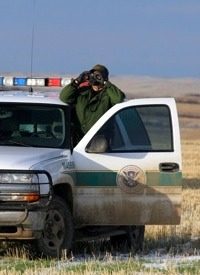
U.S. Border Patrol agents in Zapata, Texas, near the Mexican border, recently pulled over a sheriff’s vehicle from neighboring Webb County because something just looked strange, reported the Washington Post for August 30. The driver of the pickup with Webb County sheriff decals was wearing a deputy’s uniform, and swore he was a real officer. However, when the checkpoint agents called Webb County’s dispatcher, he told them he could account for all county vehicles. It seems the agents had uncovered yet another imposter — one with a thousand pounds of marijuana in his pickup.
Increasingly, canny drug gangs and smugglers on both sides of the U.S. border with Mexico are disguising their couriers and assassins in phony uniforms and vehicles, posing them as everything from mail handlers and oilfield workers to Mexican soldiers and even Texas sheriffs. Border agents have caught these traffickers hauling marijuana in fake Wal-Mart trucks and FedEx vans, as well as school buses, dump trucks, and ambulances. These counterfeit conveyances, which officials refer to as “clones,” have even included Border Patrol vehicles.
Gunmen for the paramilitary Zetas set up fake checkpoints and carry out hits in carbon copies of army trucks, while cartel commandos in masks zoom through checkpoints in pickups with forged POLICIA FEDERAL insignia, reports the Post.
“Impersonating a law enforcement asset is ingenious and disturbing,” observes Fred Burton, vice president of the Austin, Texas-based security consulting firm Stratfor. “It’s the tactic of hiding in plain sight. Cops don’t want to stop other cops.” Burton, counterterrorism adviser for the Texas Department of Public Safety and former State Department diplomatic security special agent, notes that traffickers have taken a tool from the spy’s kit. “What is going to raise more red flags on the border?” he asks. “A delivery van, or a shiny SUV with smoked windows and a new set of rims?”
“If these guys are cloning law enforcement vehicles or emergency vehicles, it’s a security risk,” adds Christopher Morrow, a highway safety analyst for Homeland Security. Jose E. Gonzalez, of the U.S. Border Patrol’s Zapata sector, agrees, noting, “Trust me, whatever you can think of, the smugglers have already thought of, and with the Internet and a decent body shop, it’s not too hard to make a clone.”
U.S. authorities report that traffickers are also utilizing retired service vehicles sold at government auctions. In 2006, Mississippi police seized nearly 800 pounds of cocaine from a van covered with Comcast, Dish and other cable company decals. The smugglers had even plastered a “How’s My Driving?” sticker with a toll-free number on the van’s rear door; the number actually belonged to an adult chat line.
“We’ve started paying attention to everything we see on the road,” declares Aaron Sanchez, of the Zapata County Sheriff’s office. Pointing to an ambulance in the county impound lot, he observes, “We found 800 pounds of marijuana in that one. The company said the ambulance had been stolen, but we’re still sorting it out.”
The U.S. government has sponsored a “first observer” program to teach truckers, bus drivers and parking lot attendants how to spot suspicious vehicles and report them to officials. “When I see a school bus filled with drugs,” says John Harris, Highway Information Sharing and Analysis Center supervisor, “I imagine it is a school bus filled with ammonium nitrate [an explosive].”
In Mexico, drug mafias pay about $1.2 billion yearly in bribes to municipal police,according to Mexican Public Safety Secretary Genaro Garcia Luna. Police corruption is so widespread in that beleaguered country that President Felipe Calderon is pushing to disband municipal departments and replace them with a national police force.
Mexicans, long accustomed to shakedowns and other officer abuses, have learned that just because people wear uniforms doesn’t mean they’re trustworthy. In fact, police — the very people meant to uphold law and order — have comprised many of Mexico’s kidnapping crews. One of the boldest of such police-related incidents was the August kidnapping and killing of Edelmiro Cavazos, Santiago’s mayor.Gangsters in seven fake police vehicles seized Cavazos from his home near Monterrey in northern Mexico. His body was found two days later, blindfolded with hands bound, dumped on a rural road. The alleged assassins were municipal police wearing federal police uniforms.
Last week at an isolated ranch in the northeastern border state of Tamaulipas, where the bound and gagged bodies of 72 illegal migrants were found, soldiers discovered that the killers had used a cloned pickup, painted olive green, with markings and plates of the Mexican army.
Two fake army pickups were also recovered last month in Tamaulipas, where drug gangs employed the clone vehicles to carry out highway kidnappings and killings in broad daylight. In June, cartel gangsters dressed as marines assassinated the leading gubernatorial candidate, Rodolfo Torre Cantu. Torre, traveling in a motorcade, was stopped by a convoy of vehicles with military insignia. Deceived, his bodyguards got out of their vehicles to speak to the uniformed men, who opened fire, spraying them with up to 120 rounds. Torre and four bodyguards were killed.
The situation is exacerbated now asMexican authorities are publicly concealing their own identities, covering their faces for fear of becoming cartel targets. With their ubiquitous black facemasks, police patrolling Mexican cities resemble bank robbers, and such disguises make it easier for criminals to impersonate them.
The threat of attacks has grown so serious that the Mexican military has even changed its uniform design, trading camouflage for more counterfeit-proof patterns, according to Enrique Torres, spokesman for military and police operations in Chihuahua. He reports that officers and soldiers are instructed to look for fakes and never assume someone is on their side based solely on appearance. “It makes our job even harder when there are criminals out there pretending to be authorities. It discredits anything good that we do.”


